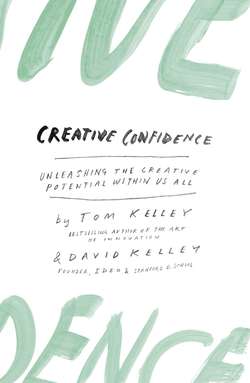Читать книгу Creative Confidence: Unleashing the Creative Potential Within Us All - David Kelley - Страница 21
THE FAILURE PARADOX
ОглавлениеA widely held myth suggests that creative geniuses rarely fail. Yet according to Professor Dean Keith Simonton of the University of California, Davis, the opposite is actually true: creative geniuses, from artists like Mozart to scientists like Darwin, are quite prolific when it comes to failure—they just don’t let that stop them. His research has found that creative people simply do more experiments. Their ultimate “strokes of genius” don’t come about because they succeed more often than other people—they just do more, period. They take more shots at the goal. That is the surprising, compelling mathematics of innovation: if you want more success, you have to be prepared to shrug off more failure.
Take Thomas Edison, for example.
Edison, one of the most famous and prolific inventors in history, had failure baked into his creative process. He understood that an experiment ending in failure is not a failed experiment—as long as constructive learning is gained. He invented the incandescent lightbulb, but only after the lessons of a thousand unsuccessful attempts. Edison maintained that the “real measure of success is the number of experiments that can be crowded into twenty-four hours.”
In fact, early failure can be crucial to success in innovation. Because the faster you find weaknesses during an innovation cycle, the faster you can improve what needs fixing. We grew up in Ohio, home of aviation pioneers Orville and Wilbur Wright. The Wright brothers are best remembered for what is sometimes called the “first flight,” in December of 1903 at Kitty Hawk. But the focus on that accomplishment overlooks the hundreds of experiments and failed flight trials in the years that led up to that first successful flight. In fact, some reports suggest that the Wright brothers picked Kitty Hawk in part because the remote Outer Banks location would draw less media attention during their experiments.
The surprising, compelling mathematics of innovation: if you want more success, you have to be prepared to shrug off more failure.
Edison and the Wright brothers may seem like ancient history, but the tradition of learning from enlightened trial and error is still very much alive today. When Steelcase decided to reinvent the traditional classroom chair—eclipsing that uncomfortable wooden version with the writing surface rigidly attached to the chair arm—they worked with our design team to build over two hundred prototypes in all shapes and sizes. Early on, they experimented with small paper-and-Scotch-tape models. Later in the project, they constructed plywood components, attaching them to pieces of existing chairs. They went to local colleges, asking students and professors to interact with these “experience models” and give feedback. They carved shapes out of foam and fabricated parts on 3D printers to get a sense of shape and size. They prototyped mechanisms in steel. And as release to manufacturing approached, they built sophisticated full-size models that looked exactly like the real thing. All that relentless experimentation—and the associated learning—paid off. The Node chair replaced the rigidity of its predecessors with a comfortable swivel seat, an adjustable work surface, casters for maneuverability, and a tripod base to hold backpacks. The result is a mobile, flexible twenty-first-century classroom chair that quickly transitions from lecture-based seating to group activities, fitting with today’s varied teaching styles. Launched in 2010, Node chairs are already in use at eight hundred schools and universities around the world.
Neither Edison nor the Wright brothers nor modern-day innovators like the design team on the Node chair were defensive or embarrassed about their method of trial and error. Ask seasoned innovators and they will likely have an impressive collection of “war stories” about failures on their path toward success.
